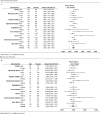Effects of calcium-containing phosphate binders on cardiovascular events and mortality in predialysis CKD stage 5 patients
- PMID: 33125428
- PMCID: PMC7598463
- DOI: 10.1371/journal.pone.0241435
Effects of calcium-containing phosphate binders on cardiovascular events and mortality in predialysis CKD stage 5 patients
Abstract
Background: Hyperphosphatemia and calcium load were associated with vascular calcification. The role of calcium-containing phosphate binders (CCPBs) use as important determinants of death and cardiovascular events in predialysis hyperphosphatemic chronic kidney disease (CKD) patients remain unclear due to the absence of evidence for reduced mortality with CCPB use compared with placebo. We aimed to investigate the effect of using CCPBs or nonuse in all-cause mortality rates and cardiovascular events in CKD stage 5 patients between 2000 and 2005 in the Taiwanese National Health Insurance Research Database.
Methods: Patients with known coronary heart disease and those who had undergone dialysis or renal transplantation were excluded. The CCPB users were matched with nonusers by the propensity score model. Multivariable Cox proportional hazards model was used to estimate hazard ratios (HRs) of all-cause mortality and cardiovascular events.
Results: During a mean follow-up of 4.58 years, 879 CCPB users were matched with 3516 nonusers. CCPB use was an independent risk factor for cardiovascular events [adjusted hazard ratio (HR) 1.583, 95% confidence interval (CI) 1.393-1.799]. The increased cardiovascular risk was dose-dependent and consistent across all subgroup analyses. Compared with no use, CCPB use was associated with no significant all-cause mortality risk (1.74 vs. 1.75 events per 100 person-years, adjusted HR 0.964, 95% CI 0.692-1.310).
Conclusions: CCPB use in CKD stage 5 patients was associated with a significantly increased cardiovascular event risk compared with the nonusers, whereas the all-cause mortality risk was similar between the two groups. Whether these relationships are causal require further randomized controlled trials.
Conflict of interest statement
The authors have declared that no competing interests exist.
Figures



References
-
- Murray CJ, Vos T, Lozano R, Naghavi M, Flaxman AD, Michaud C, et al. Disability-adjusted life years (DALYs) for 291 diseases and injuries in 21 regions, 1990–2010: a systematic analysis for the Global Burden of Disease Study 2010. Lancet (London, England). 2012;380(9859):2197–223. 10.1016/S0140-6736(12)61689-4 - DOI - PubMed
-
- Levin A, Bakris GL, Molitch M, Smulders M, Tian J, Williams LA, et al. Prevalence of abnormal serum vitamin D, PTH, calcium, and phosphorus in patients with chronic kidney disease: results of the study to evaluate early kidney disease. Kidney Int. 2007;71(1):31–8. 10.1038/sj.ki.5002009 - DOI - PubMed
MeSH terms
Substances
LinkOut - more resources
Full Text Sources
Medical

